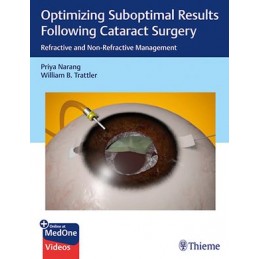- Obniżka


 Dostawa
Dostawa
Wybierz Paczkomat Inpost, Orlen Paczkę, DHL, DPD, Pocztę, email (dla ebooków). Kliknij po więcej
 Płatność
Płatność
Zapłać szybkim przelewem, kartą płatniczą lub za pobraniem. Kliknij po więcej szczegółów
 Zwroty
Zwroty
Jeżeli jesteś konsumentem możesz zwrócić towar w ciągu 14 dni*. Kliknij po więcej szczegółów
A concise review and comprehensive guide to improving cataract surgery outcomes
Significant advances have been made in refractive surgery in the last decade. Eye surgeons today can leverage many cutting-edge intraocular lens (IOL) technologies such as multifocal, extended depth of field, toric, accommodating, and aspheric. Concurrent innovations including optics, phacoemulsification, superior keratometry and biometry, and posterior cornea evaluation have resulted in improved cataract surgery outcomes. Recent advances in the diagnosis and treatment of cataracts have dramatically improved patient satisfaction following cataract surgery, yet common and rare complications still occur such as dry eye, endophthalmitis, and retinal detachment. Furthermore, only 80% of cataract surgery procedures bring patients to within 0.5 diopters of their needed refraction.
Optimizing Suboptimal Results Following Cataract Surgery:: Refractive and Non-Refractive Management presents the latest techniques for achieving optimal results and overcoming complications in cataract surgery. Internationally renowned ophthalmic surgery pioneers Priya Narang and William Trattler have created an unparalleled guide to overcoming complex cases and residual refractive errors. The book starts with six chapters on suboptimal causes and considerations, followed by dedicated sections covering refractive and non-refractive enhancements. The fourth section features chapters on keratoconus, cystoid macular edema, endophthalmitis, toxic anterior segment syndrome, and vitritis, as well as intraoperative aberrometry, futuristic approaches and advancements, and telescopic IOLs.
Key Highlights
Ophthalmologists, ophthalmology residents, fellows, and subspecialists will greatly benefit from the significant pearls and knowledge presented in this indispensable cataract surgery resource.
This book includes complimentary access to a digital copy on https://medone.thieme.com.
Opis
Part I Introduction
1 Overview of the Causes of Suboptimal Outcomes Following Cataract Surgery: Role of Preoperative Screening and Adequate Counseling
2 Tear Film and Corneal Disorders
3 Postrefractive Intraocular Lens Power Calculation: Choosing the Right Nomogram
4 Residual Refractive Error
5 Posterior Corneal Astigmatism: Basics and Clinical Implications
6 Considerations in Cataract Surgery Following Postrefractive Error Correction
Part II Refractive Enhancement Procedures
7 Corneal-Based Procedures: Astigmatic Keratotomy, LASIK, PRK, and SMILE
8 Intraocular Lens Exchange
9 Piggyback Intraocular Lens
10 Toric Intraocular Lens
11 Premium Intraocular Lenses and Associated Problems
Part III Nonrefractive Enhancement Procedures
12 Dysphotopsias and Surgical Management
13 Bullous Keratopathy and Endothelial Keratoplasty
14 Malpositioned Intraocular Lens and Capsular Bag: Intraocular Lens Complex Issues
15 Posterior Capsular Rupture and Intraocular Lens Implantation
Part IV Miscellaneous
16 Miloop: Micro-Interventional, Phaco-Free, Lens Fragmentation
17 Keratoconus and Cataract Surgery
18 Bilensectomy (Phakic IOL Explantation with Coincidental Cataract Surgery and IOL Implantation)
19 Cystoid Macular Edema and Management
20 Endophthalmitis, Toxic Anterior Segment Syndrome, and Vitritis
21 Intraoperative Aberrometry
22 Futuristic Approach and Advancements
23 Telescopic Intraocular Lenses
Indeks: 90459
Autor: Liuska M. Pesce
